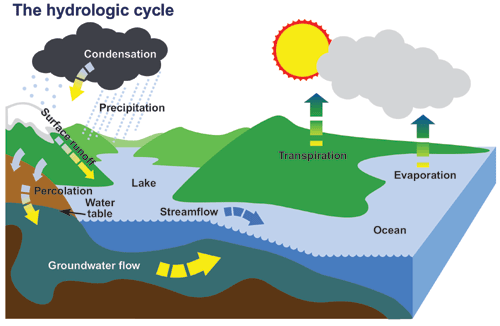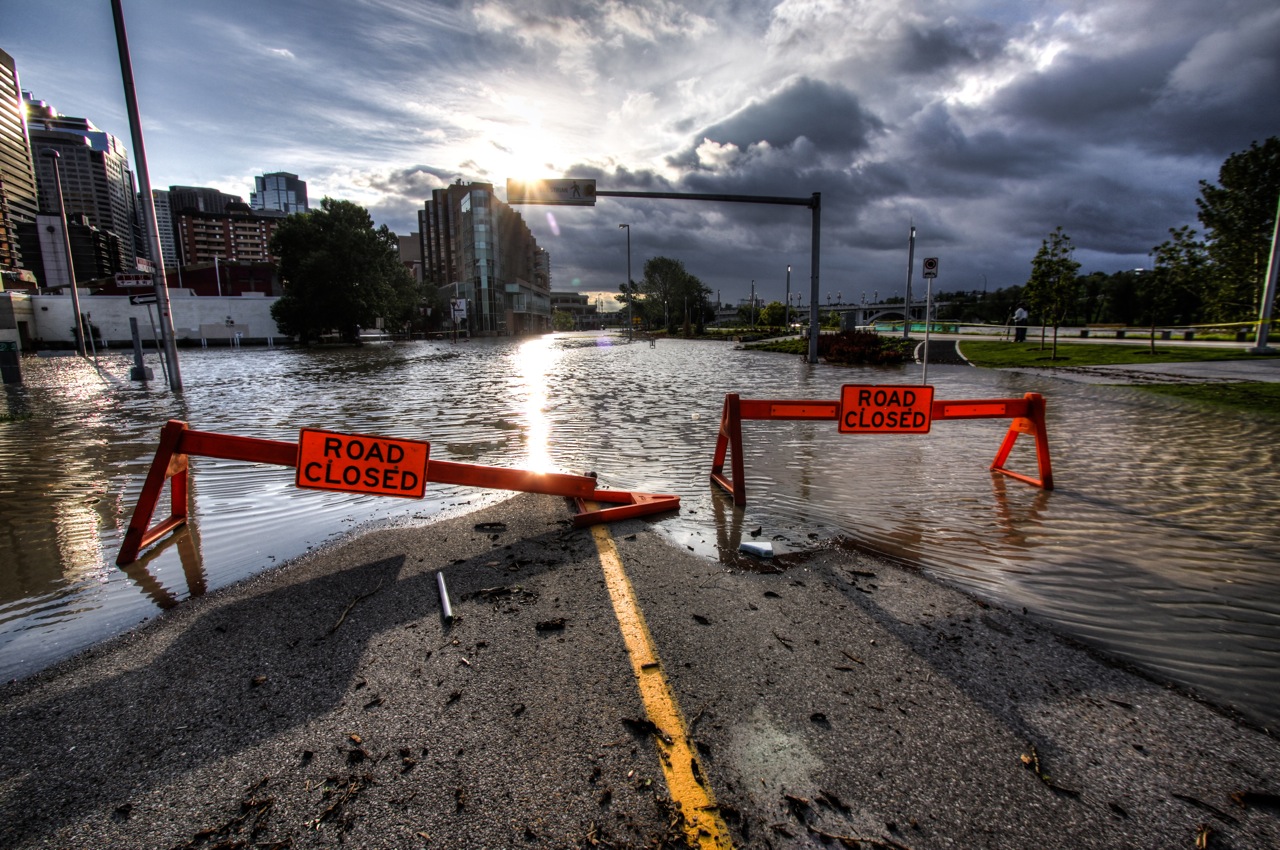How urban resiliency is a triple bottom line winner for Alberta
By Laura Corbeil, Steve Herman and Alexander J.B. Zehnder
All over the world, people are asking questions about climate change. When will it affect us, how will it change our everyday activities, and what can we do about it? How do we prepare for the economic, social and environmental (triple bottom line) risks and opportunities?
These questions have complex responses that vary between communities and continents, but with the conversation started people are already creating answers for Alberta.
The reality is climate change is already underway; in Alberta, we have witnessed increasingly warmer temperatures, a trend that is predicted to continue and even intensify. It is expected climate change will produce more heat waves, floods and droughts as well as earlier snowmelt and the disappearance of glaciers.
 |
|
Figure 1: The hydrologic cycle. Temperature driven transpiration, evaporation and melting will increase with higher ambient temperatures, influencing the entire cycle. Source: Environment and Climate Change Canada |
It is no coincidence all of these impacts are connected to water, as climate change has pronounced effects on global, regional, and local water systems. These systems directly influence our way of life because they control water flow, availability, and quality.
Water is critical to our lives. We drink it, use it to grow our food, play in it and so much more. We are also impacted by water’s natural cycle (Figure 1) for instance the timing of precipitation and impacts on crops. Higher temperatures are predicted to impact the hydrologic cycle in many other ways, including:
- Water quality,
- Climate variability,
- Extreme weather condition frequency and/or severity, and
- Earlier snowpack melt.
All these impacts increase risks relating to water quality, quantity, and reliability; a direct result of the interconnectedness of the hydrological cycle. As we become more familiar with the possible impacts of changes to the hydrologic cycle, the question becomes: are we ready for them as best we can be?
Increasing urban resiliency
Resiliency is one of today’s hottest buzzwords in the climate change discussion, and for good reason. In the context of climate change, being resilient means being ready for the negative impacts of a changing climate; it means answering, “Are we ready as best we can be?” with a firm, “Yes!”
Increasingly, cities and communities are working to develop urban resiliency, which means the natural and built infrastructure and systems where we live can survive or endure disastrous events (like flood), as well as adjust to more gradual changes over time (like shorter winter seasons).
Due to unique local characteristics that can increase or decrease a community’s vulnerability to risks, challenges from extreme events and gradual climatic changes will be different everywhere.
Although many agree it is important for communities to build resiliency, the costs associated with building urban resiliency are often a barrier to action. However, long term costs of inaction are expected to be much higher.
One way to consider the possible costs of future climate change related events is to reflect on events which have already occurred and are expected to become more frequent and/or severe.
 |
|
Figure 2: Flooding is an example of climate change related risks, which could become more common throughout Alberta. Image Source: Wikimedia Commons |
For example, the 2013 flooding in Alberta was estimated to cost the province $5-7 billion, while our most recent drought cost the Canadian economy $5.8 billion. These figures represent the potential cost of inaction, price tags we could expect to see again and again if we change nothing.
The United Nations estimates the global cost of building resiliency to be $65-226 billion; the costs to fix destruction from climate related disasters can reach at least fifty to a hundred times higher sums let alone the loss of human lives.
Building urban resiliency could also make money
Building resiliency is expected to reduce the cost of damage by orders of magnitude and, although up-front costs may seem high, these actions will save money in the future. This alone should be enough encouragement for taking action. But what if building urban resiliency could be a money generator rather than only reducing potential costs?
Resiliency challenges us to create solutions for a world we have not seen yet, benefiting communities beyond reducing the cost and damage of extreme events. Answering the question, “How do we plan and build inherently resilient places to live?” will be, and already is, a driving force for innovation.
Because climate change is a global problem it provides global economic opportunities—ideas that reduce risk in our communities can also be turned into a successful business model at home and abroad.
Alberta examples of urban resiliency planning
Here are a few, brief case studies highlighting what local participation, government leadership, and human innovation can accomplish.
In recognition of environmental, economic and social costs of inaction, Albertan municipalities are taking a lead on urban resiliency planning. For example, Calgary, Canmore[1], Edmonton, Red Deer, and some First Nation groups are in the process of developing climate change adaptation plans.
In addition to municipality planning, there are ongoing research projects with implications for regional urban resilience.
For example, Canadian government funding enables research initiatives such as Global Water Futures: Solutions to Water Threats in an Era of Global Change (GWF) [2]. This research focuses on the impacts of climate change on water, snow, and ice in Canada’s mountainous regions, which has implications for the water-related resilience of urban areas throughout Alberta.
Additionally, Alberta Innovates provides funding through its Water Innovation Program [3] for projects furthering the goals of Alberta’s Water for Life Strategy. The projects range in scope and size, though they can all be classified according to the following focus areas:
- Future water supply and watershed management
- Healthy aquatic ecosystems
- Water use conservation, efficiency, and productivity, and
- Water quality protection.
These projects aim to improve the safety and security of drinking water, aquatic ecosystem health, and reliability of water supply for industrial uses throughout Alberta, even as the climate changes.
Some research and assessments are undertaken at a desktop level, such as the Public Infrastructure Environmental Vulnerability Committee (PIEVC) engineering assessments, which analyze the vulnerability of infrastructure to climate change across Canada.
In 2011, a case study of Calgary’s water supply infrastructure was performed using the PIEVC Protocol [4]. Components of Calgary’s water supply infrastructure included dams and reservoirs, raw water intakes, pumping stations, storage facilities, treatment plants, power sources and buildings. The watershed as a whole was also considered a component of water supply infrastructure, since it encompasses precipitation quantity and type (rain versus snow), as well as stream flow timing and quantity, which are at risk of alteration under a changing climate. Access the full report here.
Alberta is ripe for the opportunity
Climate change is having a profound effect on our hydrologic system, and is expected to increase water related risks such as flooding, drought, and long term shifts like loss of glaciers and earlier snowmelt. Costs associated with building urban resiliency are often a barrier to action; however we now know the cost of inaction will be far greater.
Adaptation to climate change risk through urban resilience is imperative for maintaining Alberta’s health and prosperity. Building resilience through adaptation can reduce future damage costs from extreme weather events like floods and droughts by orders of magnitude. At the same time, focused planning and support on preparedness initiatives creates opportunities for economic and technology developments for Alberta on a local, regional, and global scale.
– – – – –
Authors
Laura Corbeil is an environmental scientist and avid urban cyclist living, working, and playing in Calgary, Alberta. She currently works with Alberta WaterSMART on a variety of projects promoting collaborative water management.
Steve Herman is a chemical engineer with Alberta WaterSMART, and is currently pursuing his Master’s degree in Chemical and Petroleum Engineering with a specialization in Energy and Environmental Engineering at the University of Calgary. His passion and interest in conserving our water resources stems from fond memories of floating down Calgary’s rivers and longs days at the beach at his grandparents’ cabin.
Alexander J.B. Zehnder is an advisor to Alberta Innovates for water and environmental issues. He is the founder and director of Triple Z Ltd, Visiting Professor at NTU, Singapore and Professor emeritus of ETH Zurich. His major knowledge areas comprise qualitative and quantitative aspects of water, water policy, relation between food and water security, virtual water trade, water infrastructures; scientific and economic fundamentals for sustainable development; developing capital market instruments; managing small and medium enterprises and large public institutions and universities.
